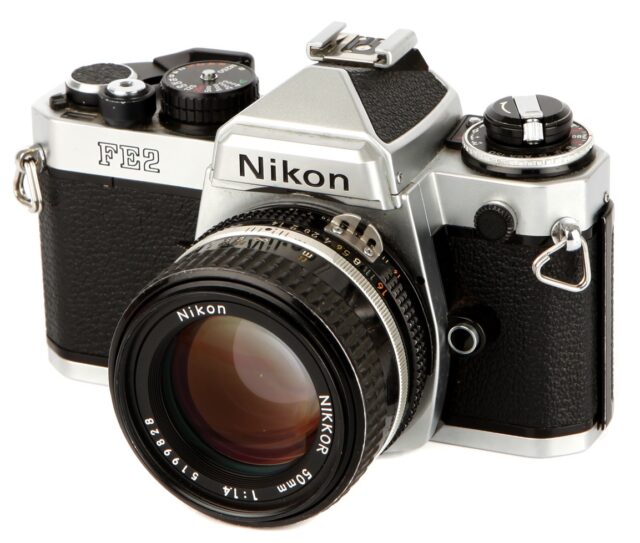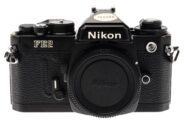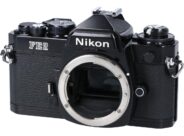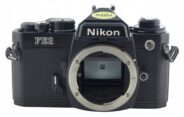Announced
Production status
System
Nikon F system cameras
- Nikkorex F
- Nikkormat EL
- Nikkormat ELW
- Nikkormat FS
- Nikkormat FT
- Nikkormat FT2
- Nikkormat FT3
- Nikkormat FTN
- Nikon D3
- Nikon D3s
- Nikon D3X
- Nikon D4
- Nikon D4s
- Nikon D5
- Nikon D6
- Nikon D600
- Nikon D610
- Nikon D700
- Nikon D750
- Nikon D780
- Nikon D800
- Nikon D800E
- Nikon D810
- Nikon D850
- Nikon Df
- Nikon EL2
- Nikon EM
- Nikon F
- Nikon F100
- Nikon F2
- Nikon F3
- Nikon F4
- Nikon F5
- Nikon F6
- Nikon FA
- Nikon FE
- Nikon FE10
- Nikon FE2
- Nikon FG
- Nikon FG-20
- Nikon FM
- Nikon FM10
- Nikon FM2
- Nikon FM2/T
- Nikon FM3A
- Nikon N2000
- Nikon N2020
- Nikon N4004
- Nikon N4004S
- Nikon N50
- Nikon N5005
- Nikon N55
- Nikon N60
- Nikon N6000
- Nikon N6006
- Nikon N65
- Nikon N70
- Nikon N75
- Nikon N80
- Nikon N8008
- Nikon N8008S
- Nikon N90
- Nikon N90S
Nikon FE2
35mm MF film SLR camera • Discontinued
Specification
| Format: | |
| 35mm full frame | |
Film type: | 135 cartridge-loaded film |
| Nikon F [46.5mm] | |
| Shutter: | |
Type: | Focal-plane |
Model: | Electronically controlled |
Speeds: | 8 - 1/4000 + B |
| Exposure: | |
Exposure metering: | Through-the-lens (TTL), open-aperture |
Exposure modes: | Aperture-priority Auto |
| Manual | |
| Physical characteristics: | |
Weight: | 550g |
Dimensions: | 142.5x90x57.5mm |
Manufacturer description #1
INTRODUCING THE AUTOMATIC NIKON FE2 WITH TTL FLASH METERING AND THE WORLD'S FASTEST 35MM SLR SHUTTER.
Many of your customers are finding their photographic talents stifled due to the limits of their present camera. Because in the few years since they stepped up to their first 35mm SLR, they've grown more sophisticated than their camera's features. But now there's a new Nikon that can take these photographers to the next level and beyond - the Nikon FE2.
A STEP BEYOND ANY COMPETITION
The new Nikon FE2 represents a time-proven concept with a unique high-performance additive. Take its three major features - aperture-priority automatic exposures, "true" match-needle manual metering and automatic TTL flash control - and the competition dwindles. Add the new exclusive Nikon high speed titanium shutter with a top speed of 1/4000 sec. and X-synch at 1/250 sec. and there is no competition. And as far as quality, durability and dependability goes, the name Nikon sells itself.
AUTOMATIC OR MANUAL
On automatic, the Nikon FE2 sets the shutter speed steplessly over a wide range from eight full seconds to an action-stopping 1/4000 sec. Shift the FE2 into manual and a quartz oscillator vibrating at 32,758 pulses-per-second, times the shutter speeds with consistent accuracy, frame after frame and year after year. And there's even a mechanically-controlled 1/250 sec. shutter speed.
SUPERIOR TTL FLASH CAPABILITY
When it comes to flash photography, the Nikon FE2 is superior to any other 35mm SLR camera because it permits flash photography at up to 1/250 sec. - a feat previously possible only with bulky medium and large format cameras. This all but eliminates ghost images and allows the use of wider apertures for creative selective focus shooting. Plus, the function of automatic through-the-lens flash metering will increase any photographer's photographic capabilities. Because TTL flash with the Nikon FE2 is as quick and easy as setting an f/stop. The Nikon SB-15 or new Nikon SB-16 Speedlight automatically programs the FE2 to the proper X-synch speed and the LED flash ready-light blinks to warn the user of potential mistakes. Plus, the system automatically compensates for filters, lens extension or bounce illumination.
MORE FEATURES FOR BETTER PICTURES
Still, with all these tremendous features, your customers will immediately notice the improved brightness of the viewfinder image. Through a special process, the interchangeable focusing screens literally snap into focus, even in dim light.
And all they need to know to take a great picture is clearly visible outside the focusing area -shutter speed scale with mode indicator and meter needle, Aperture-Direct Readout, and even an LED warning light to signal that the exposure compensation dial has been switched from its normal position. And while other cameras may also have an exposure memory lock, this control on the Nikon FE2 can also be used for fast bracketing of the automatic exposure. Other features include an energy-saving meter switch built into the shutter release button, self-timer and special control lever for intentional multiple exposures.
Like all Nikon SLRs, the new FE2 is backed up by the most extensive system of lenses and accessories in photography. Nearly 70 Nikkor and Nikon Series E lenses. The MD-12 Motor Drive for automatic film advance at over three frames-per-second. And the new MF-16 Data Back with direct internal contacts.
So, when your customers shop for a camera, you now have a camera they won't outgrow. The new Nikon FE2.
Manufacturer description #2
The Nikon FE2 combines the latest advances in photographic technology with a time-proven body design for the utmost in performance. A Nikon-designed high-speed titanium shutter provides a range of shutter speeds from eight full seconds to 1/4000 sec. On automatic, the speeds are stepless and electronically timed, while digttal quartz timing ensures consistent shutter-speed accuracy in manual. Synchronization with electronic flash is now possible at all speeds up to 1/250 sec.
The FE2 features a full-information viewfinder, which displays all camera functions. The shutter-speed scale has a green needle to confirm automatic operation or indicate the manually-selected shutter speed. A black needle moves to point to the metered speed. The window at the top shows the set lens aperture, and an LED on the right side lights to remind the user when the exposure compensation dial has been switched from its normal position. A new chemical process applied to the interchangeable focusing screen delivers about one stop more light so subjects literally snap into focus.
An energy-saving meter switch is built into the oversized shutter-release button. Moving the film-advance lever to its 30° standoff position unlocks the shutter release, and slight pressure on it activates the meter for 16 seconds. The FE2 is operable without batteries when the shutter speed dial is set to the "M250" position for mechanical shutter firing at 1/250 sec. To bias the meter for unusual lighting conditions the exposure compensation dial can be set from +2EV to -2EV in 1/3-stop increments. And, on automatic, the FE2's exposure memory lock can be used to properly expose a subject standing near the edge of the frame. Because the memory lock freezes the automatic shutter-speed setting, photographers can quickly bracket exposures by changing the aperture. The FE2 also features a depth-of-field preview lever, electronic quartz-timed self-timer and multiple exposure lever.
The camera also incorporates automatic through-the-lens (TTL) flash metering. A light sensor at the bottom of the FE2 camera body measures the precise amount of light striking the film and automatically controls flash output. When the Nikon Speedlight SB-15 or SB-16B is mounted on the FE2 s hot shoe, turned on and recycled, the camera's shutter is automatically switched to 1/250 sec. X-synch speed from the AUTO mode or any manual speed of 1/500 sec. or faster. At slower speeds, the shutter fires at the set speed while TTL flash control is maintained. An LED at the top of the eyepiece lights to confirm that the flash is charged. This same LED will blink after an exposure if the flash emits its full light output, signalling an under-exposure may occur. The FE2 also has a standard PC terminal. The FE2 can be adapted for true motor-drive operation by directly coupling the MD-12 Motor Drive. To imprint the date or time onto the film, the FE2 accepts either the MF-12 or MF-16 Data Back. Backed by the Nikon system of lenses and accessories, the FE2 offers limitless photographic possibilities.
High-Speed Titanium Shutter
The vertically-travelling titanium shutter curtains traverse the film gate at nearly twice the speed of conventional shutters, a mere 3.3 milliseconds. This all but eliminates image distortion, a phenomenon common to focal plane shutters. The etched, modified honeycomb-pattern titanium used in the curtains assures great durability and a more than 50% reduction in shutter mass, so there's virtually no camera shake in hand-held shooting. Shutter travel is stable and a wide, 1.8mm slit width at 1/4000 sec. virtually eliminates any chance of uneven exposures.
Full-Information Viewfinder
Nonobstructed viewfinder shows Aperture-Direct Readout at top; shutter-speed scale has green bar to show auto mode or manually set shutter speed; moving needle indicates metered speed and over/under-exposure warning. When exposure compensation dial is switched from normal "0" position, LED at right lights.
Shutter-Speed Dial
Large knurled dial locks at 'W' position for aperture-priority automatic exposure control. Center button unlocks dial to set any quartz-timed manual speed from 8-1/4000 sec., plus B. Flash sync is marked in red at "250." In the event of battery failure, set dial at "M250" to drop mirror and fire shutter mechanically at 1/250 sec.
TTL Flash Metering
When used with the Nikon Speedlight SB-15 or SB-16B, the silicon photo diode at base of mirror box measures flash illumination directly off the film plane during the exposure. These units automatically program the camera's shutter to the proper X-synch speed (1/250 sec.) from the AUTO mode or manual speed above 1/250 sec. and activate the FE2's LED flash ready-light at the top of the eyepiece. LED blinks after exposure if full light output may result in underexposed flash exposure. Lens may be set at any aperture from f2 to f22, depending on subject distance.
Interchangeable Focusing Screens
The extra-bright K2 focusing screen supplied with the FE2 has central split-image rangefinder spot and micro-prism collar with 12mm diameter center-weighted metering sensitivity area. To remove, press the latch at the top of the mirror box. Optional B2 screen with matte focusing spot or E2 with etched horizontal and vertical grid lines are available for the FE2, FM2 and FE cameras. New screens may be used in FM2 and FE with exposure compensation.
Exposure Compensation
Biases the automatic or manual meter reading from +2EV to - 2EV in precise 1/3-stop increments. Chrome button releases dial. Warning signal lights in the viewfinder to remind user that the dial has been moved from its normal position.
Self-Timer / Exposure Memory Lock
To set self-timer for 10-second firing delay, the lever is rotated counterclockwise. Timing cycle may be cancelled. Lever doubles as an exposure memory lock. When pushed towards the lens mount, the automatic shutter-speed setting is held. This permits photographing a subject near the edge of the frame after taking a proper, center-weighted meter reading. It also allows fast bracketing on automatic by changing the aperture.
Meter Switch / Release Lock
Film advance lever unlocks shutter release button when offset 30° from camera body. Energy-saving meter switch is activated by light pressure on shutter release and turns off automatically 16 seconds after pressure is removed. Accepts standard threaded mechanical cable release.
Depth-of-Field Preview
Depth-of-field preview lever enables visual determination of actual overall range of sharp focus by stopping down the lens to its set aperture.
Multiple-Exposure Lever
Lever adjacent to film advance disengages transport mechanism for intentional multiple exposures. Film registration is well maintained even while one makes multiple exposures with a motor drive. Frame counter does not advance.
Manufacturer description #3
TYPE OF CAMERA: Electronically-controlled 35mm SLR
PICTURE FORMAT: 24mm x 36mm (standard 35mm format)
LENS MOUNT: Nikon bayonet mount
LENSES: AI-Nikkor and Nikon Series E lenses; Non-AI lenses cannot be mounted
SHUTTER: Electronically-controlled, vertical-travel metal focal plane shutter with titanium curtains
SHUTTER RELEASE: Mechanical: on Auto/Manual; center-threaded shutter-release button accepts AR-3 Cable Release; button locked when film-advance lever is flush with camera body; Mechanical backup shutter release: M250 (1/250 sec.) and B
METER SWITCH: Pressing shutter-release button halfway down switches meter on; meter stays on for 16 seconds then automatically switches off; meter turned off when shutter speed dial is set at M250 or B
EXPOSURE CONTROL: Aperture-priority automatic exposure control with shutter speed dial set on A; manual exposure control by turning shutter speed dial and/or lens aperture
SHUTTER SPEEDS: On Auto: stepless speeds from 8 to 1/4000 sec.; on Manual: 16 quartz-timed speeds from 8 to 1/4000 sec., on Mechanical: M250 (1/250 sec.), B
FILM-ADVANCE LEVER: Single-stroke type with 30 deg. stand-off angle and 135 deg. winding angle
VIEWFINDER: Fixed-eyelevel pentaprism type; 0.86X magnification with 50mm lens at infinity; 93% frame coverage
VIEWFINDER DISPLAY: Shutter speed scale with meter needle and shutter speed/exposure mode indicator bar and over-/underexposure warning area; aperture-direct readout of set f/number; LED exposure compensation mark lights when dial is off "0" position
FOCUSING SCREEN: Interchangeable matte Fresnel focusing screen with central split-image rangefinder spot and micro-prism collar (Nikon Type K2) as standard
REFLEX MIRROR: Automatic instant-return mirror
SELF-TIMER: Quartz-timed 10-sec. delay; may be cancelled
EXPOSURE MEMORY LOCK: Via self-timer lever
MULTIPLE EXPOSURE LEVER: Provided
ACCESSORY SHOE: Standard ISO type; hot shoe, ready-light, monitor and TTL control contacts provided
FLASH SYNCHRONIZATION: On Auto: 1/250 sec.; On Manual: 1/250 sec. or lower, or at 1/250 sec. only when shutter speed dial is set between 1/500 sec. and 1/4000 sec.
PC TERMINAL: Provided; threaded
FLASH READY-LIGHT: LED visible at top of eyepiece; lights up when SB-16B, SB-15, SB-E or SB-10 Speedlight is charged; blinks to warn of underexposure during TTL operation
EXPOSURE METERING: Through-the-Iens center-weighted full-aperture-exposure measuring system using two silicon photo diodes
METERING RANGE: EV 1 to EV 18 at ASA/ISO 100 with f1.4 lens
TTL FLASH METERING: Photo cell at base of mirror box measures flash exposures off the film plane during TTL operation with SB-15 or SB-16B
EXPOSURE COMPENSATION: ±2EV in 1/3 increments
FILM SPEED RANGE: ASA/ISO 12 to 4000
FRAME COUNTER: Additive type; automatically resets to "S" two frames before "0", when camera back is opened; on Auto, shutter speed is 1/250sec. until frame "1" is reached
POWER SOURCE: Choice of one 3V lithium battery, two 1.55 V silver-oxide batteries or two 1.5V alkaline-manganese batteries; optional Anti-Cold Battery Holder DB-2 accepting two AA-type penlight batteries available
BATTERY CHECK: By pressing shutter-release button halfway while looking through the viewfinder; if there is sufficient power, the black needle will move; if not, the black needle will remain at the bottom of the shutter-speed scale
DEPTH-OF-FIELD PREVIEW LEVER: Provided
FILM REWIND: By crank provided
CAMERA BACK: Interchangeable with MF-12 or MF-16 Data Back; pops open when the film rewind-knob is pulled up as camera back lock is pushed counterclockwise; memo holder provided
Similar cameras (4)
35mm full frame • Manual focus • Film • Singe-lens reflex • Nikon F mount
| Model | Shutter | Metering | Modes | Year |
|---|---|---|---|---|
| Kiev-17 aka Киев-17 |
M, 1/1000 | -- | M | 1978 ● |
| Kiev-19 aka Киев-19 |
M, 1/500 | TTL • WA | M | 1985 ● |
| Kiev-19M aka Киев-19М |
M, 1/500 | TTL • OA | M | 1988 ● |
| Kiev-20 aka Киев-20 |
M, 1/1000 | TTL • OA | M | 1983 ● |







